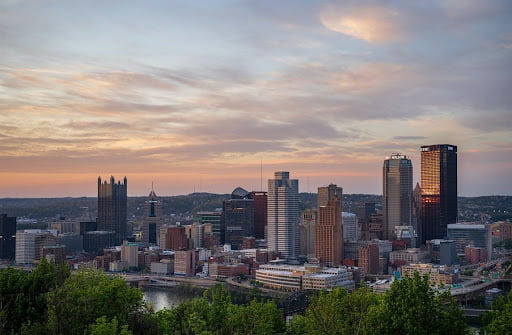
The demands of creating a cleaner, greener, and more sustainable Pennsylvania come from concerned citizens, nature enthusiasts, and advocates for environmental conservation alike. The glorious state of Pennsylvania is undoubtedly well-owed with natural beauty and rich cultural heritage. However, it also faces diverse environmental challenges demanding our attention.
That’s why this blog helps you navigate the landscape of environmental issues in Pennsylvania while letting you understand their potential implications for future generations. These issues include:
Table of Contents
Deforestation
The trees of Pennsylvania have been facing the monster of deforestation since the 1800s. From timber barons to charcoal industry tycoons – everyone contributed to the clearing of the precious forests of Pennsylvania. Even today, these trees are threatened by too many species, plant invaders, and lots of deer. Since trees absorb carbon dioxide, clearing forests causes all these harmful gases to release right into the environment. Forest loss is responsible for some 10% of global warming worldwide.
Asbestos Exposure
Lead and asbestos exposure leads to many health complications among Pennsylvania residents. That’s why, in 2020, the state government proposed using a billion dollars in funding to remediate asbestos-tainted schools in the Commonwealth. That’s because 17,000+ lives were lost between 1999 and 2017 due to asbestos-related diseases like mesothelioma. But what to do if you are exposed to asbestos?
Mesothelioma happens after long-term asbestos exposure and may take years to manifest itself. Some recommended resources to help mesothelioma patients include hiring an asbestos attorney. Lawyers will help you win compensation for your sufferings if you were exposed to asbestos in your school or workplace. So, pursue justice by working with a mesothelioma attorney to obtain financial compensation.
Air pollution
Some Pennsylvanian cities rank the worst in the nation for particle pollution. Air pollution leads to lung and heart diseases along with many other ailments. While manmade sources contribute significantly to air pollution – e.g., vehicles, factories, and mining operations – we cannot rule out the role played by wildfires, volcano eruptions, and windblown pollen in this regard.
Land pollution
Eliminating land pollution is necessary to produce cleaner and toxin-free crops. This big environmental challenge is more prevalent on farmland when pollutants like zinc and lead have made the foods toxic for human consumption. Zinc seeps into growing plants and spoils them before we can even eat them.
However, the state government spends some $68 million to clean up the trash and educate the citizens of Pennsylvania about the evils of littering. Fewer trash leads to fewer concerns about land pollution.
Water pollution
A recent study shows that a third of all Pennsylvanian waterways are riddled with pollutants harmful to wildlife and human beings. Almost 20,000 miles of rivers and streams in the state have become too dangerous for fishing and swimming. That’s because local companies keep dumping toxic waste into the state’s waterways, such as copper, grease, and aluminum.
But things are a-changing as the EPA proposes new laws to curb water pollution nationwide. So, this rule will strengthen law enforcement and help maintain clean waterways. With persistent efforts, we may solve the water pollution issue successfully.
Climate change
In 2020, Pennsylvania became the fourth-largest greenhouse-emitting state in America. Most of these harmful emissions come from burning methane – a climate pollutant more toxic than carbon dioxide – and fossil fuels. Data shows that one-fifth of the state’s climate pollution comes from twelve major firms collectively called the “dirty dozen.” These power plants and industrial facilities are contributing heavily to polluting the environment and making Pennsylvania a hazardous commonwealth.
Some outcomes of climate change include rising temperatures, extreme weather events, and changing precipitation. For instance, the average annual rainfall in the commonwealth has increased by 5 to 10 percent in the last century. Along with torrential rainfall, flash flooding has also increased.
Loss of natural habitats
Unplanned and excessive urban development threatens the survival of biodiversity in Pennsylvania. It is observed that the energy, housing, and agriculture sectors in the state have led to different species’ decline. Expanding suburbs and generations of road building are also two important factors behind an accelerated decline in the abundance of wildlife. Some at-risk species in Pennsylvania include:
- Evening grosbeak
- Eastern hellbender
- Wetland butterflies
- Freshwater mussels
- Northeastern bulrush
This continuous habitat destruction leads to natural disasters, such as deluges, droughts, crop failures, water contamination, and many other environmental issues.
Invasive species
The introduction of invasive species in the native environment is yet another threat to Pennsylvania’s local wildlife and biodiversity. Many different species aren’t native to Pennsylvania’s environment and threaten the survival of native wildlife, such as hemlock, Norway maple, and the tree of heaven.
They disrupt native ecosystems, outcompeting local species and affecting the ecological balance. That is why authorities must prevent people from altering Pennsylvania’s natural habitats on a whim.
Fracking and gas drilling
While the petroleum industry claims that fracking is a harmless process of extracting oil/gas, research has proven otherwise. A study shows that kids living near Pennsylvania wells where fracking happens are 2 to 3 times more likely to develop childhood leukemia. Similarly, fracking has been linked to many other health concerns, e.g., depression, skin/urinary issues, and low birth rates among people.
Urban sprawl
Urban sprawl – commonly known as “rapid urbanization” – happens when people move from major cities to rural areas. Unfortunately, Pennsylvia’s population took a serious toll during the COVID crisis and shrank by 17% between 2020 and 2022. In a year alone, Pennsylvania set the record for the fourth-highest population loss in the nation when 40,000 of its residents outmigrated.
However, urban sprawl increases pollution, habitat fragmentation, and loss of green spaces. It promotes a more car-dependant culture, thereby causing higher harmful emissions.
Conclusion
This blog discusses several major environmental challenges facing Pennsylvania right now. From concerns over air and water quality to habitat loss and climate change – addressing these problems has now become vital to preserve Pennsylvania’s natural beauty and biodiversity. As the state confronts the rising monster of climate change, both government efforts and grassroots movements need to play their role in fighting deforestation and pollution. The battle for sustainability is an attempt to save our future generations!


